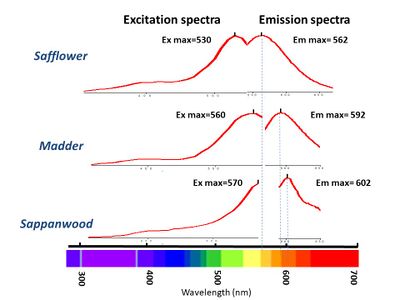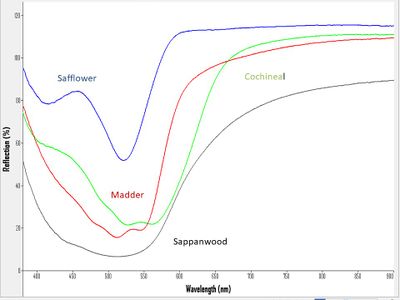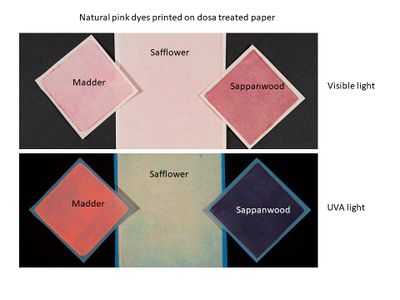Sappanwood: Ukiyo-e colorant
Sappanwood 蘇芳 (suō): A red dye extracted from several tropical trees, such as Paubrasilia echinata, commonly known as brazilwood from Brazil and Biancaea sappan, commonly known as sappanwood from Southeast Asia. Its principal colorant is Brasilin, a hydroxyanthraquinone, that gives a deep red to brownish color when it is oxidized to form brasilein.
Sappanwood has been detected but the use of it appears to have been infrequent. Due to its sensitivity to pH, sappanwood can be manipulated to produce a range of colors as pink, red, or oranges. It is unknown if printers adjusted the pH to create a range of colors. Evidence of pH manipulation is difficult to extrapolate from the prints themselves since many of the examples have discolored to a dull pinkish brown due to fading and/or ageing.
For additional information see: Sappanwood, Biancaea sappan (Kew)
Examples of Sappanwood in Ukiyo-e Prints
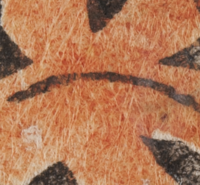
|
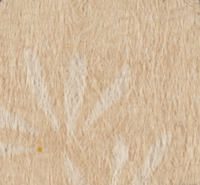
|
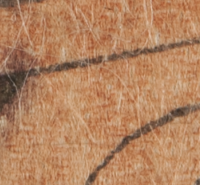
|
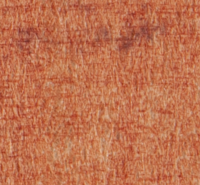
|

|
Analysis
Excitation Emission Matrix (EEM) spectroscopy can easily identify the organic reds: safflower, madder, and sappanwood. Sappanwood only fluoresces slightly under UVA radiation and produces a unique EEM pattern.
Images of Sappanwood
List of Prints
Below is a list of prints where sappanwood was detected.
Pages in category "Sappanwood: Ukiyo-e colorant"
The following 33 pages are in this category, out of 33 total.
B
E
H
- Harunobu, Courtesan Watching Two Kamuro Make a Snow Dog, 21.4463
- Harunobu, Parody of Saigyô Hôshi: Courtesan Looking at a Screen Painting of Mount Fuji, 11.19431
- Harunobu, The Sake Cup, sheet 4 of the series Marriage in Brocade Prints, the Carriage of the Virtuous Woman, known as the Marriage series, 11.19475
- Harunobu, The Tenth Month, from an untitled series of Twelve Months, 11.20124
- Harunobu, Young Woman Riding a Turtle (Parody of the Story of Urashima Tarô), 21.4594
- Harunobu, Young Woman Tuning a Shamisen, 06.479
- Hokkei, Ômori, from the series Souvenirs of Enoshima, a Set of Sixteen, 11.19845
- Hokusai, Act IX, from the series The Storehouse of Loyal Retainers, a Primer, 11.17643
- Hokusai, Act VI, from the series The Storehouse of Loyal Retainers, a Primer, 11.17586
- Hokusai, Act X, from the series The Storehouse of Loyal Retainers, a Primer, 11.17583
- Hokusai, Bun'ya no Yasuhide, from an untitled series of the Six Poetic Immortals formed by the characters for their names, 21.10217
- Hokusai, Kaminari Shôkurô with a Courtesan, from an untitled series of the Five Manly Men, 11.19684
- Hokusai, Procession of a Daimyô Passing Shinagawa on the Way to Kyoto, from the series Newly Published Perspective Pictures, 21.10203
K
- Kiyomasu II, Actors Ôtani Hiroji II as Washi no Chôkichi and Arashi Tominosuke as Tarui Osen, 21.5458
- Kokan, Couple Cooling Off on a Garden Bench, 11.19524
- Komatsuken, Courtesan Parading with Two Kamuro, 11.19711
- Komatsuken, Young Man as the Bodhisattva Monju, 11.30137
- Komatsuken, Young Woman as the Bodhisattva Fugen, 11.30136
- Koryusai, Descending Geese at Mimeguri, from the series Fashionable Eight Views of Edo, 11.14627
- Kunisada, Actors Iwai Kumesaburô II as Agemaki (R), Ichikawa Danjûrô VII as Sukeroku (C), and Onoe Kikugorô III as Shinbei (L), 21.7532-4
- Kuniyoshi, Hosokute: Horikoshi Dairyô, from the series Sixty-nine Stations of the Kisokaidô Road, 11.28766
S
- Shigemasa, Perspective Picture of the Sleeping Dragon Plum in the Plum Garden at Kameido, 11.14977
- Shigenobu I, Puppy Playing with a Ball, 21.9257
- Shinsai, Chapters 16–18, from the series The Tale of Genji, 11.21066
- Shinsai, Chapters 22–24, from the series The Tale of Genji, 11.20034
- Shinsai, Chapters 25–27, from the series The Tale of Genji, 21.9264







